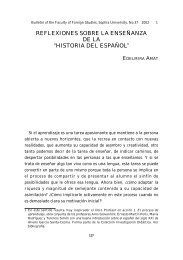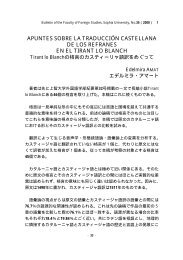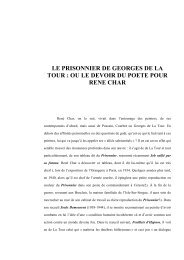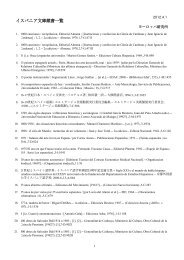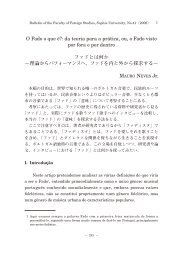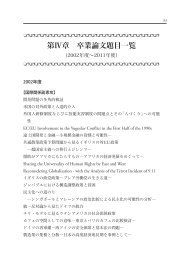Forgotten Paths to NEPA: A Historical Analysis of the Early ...
Forgotten Paths to NEPA: A Historical Analysis of the Early ...
Forgotten Paths to NEPA: A Historical Analysis of the Early ...
Create successful ePaper yourself
Turn your PDF publications into a flip-book with our unique Google optimized e-Paper software.
Joseph DiMen<strong>to</strong> and Kazu<strong>to</strong> Oshio<br />
mental movement shared with <strong>the</strong> antiwar movement, <strong>the</strong> civil rights movement,<br />
or <strong>the</strong> feminist movement.” 11<br />
However, <strong>the</strong>re are a few exceptional attempts <strong>to</strong> integrate environmentalism<br />
in<strong>to</strong> <strong>the</strong> s<strong>to</strong>ry <strong>of</strong> <strong>the</strong> 1960s. Yet <strong>the</strong> works typify <strong>the</strong> above stated problem<br />
because <strong>the</strong>y emphasize that environmentalism “s<strong>to</strong>od out as a legacy <strong>of</strong> <strong>the</strong><br />
reform spirit <strong>of</strong> <strong>the</strong> 1960s” but devote only a handful, out <strong>of</strong> nearly 800 pages, <strong>to</strong><br />
environmental issues. There is <strong>the</strong>n a missing link between <strong>the</strong> 1960s and<br />
environmentalism, which is <strong>the</strong> subject <strong>of</strong> inquiry <strong>of</strong> this short article. 12 Our<br />
attempt is <strong>to</strong> locate <strong>the</strong> emergence <strong>of</strong> environmental law as an academic field<br />
within <strong>the</strong> context <strong>of</strong> <strong>the</strong> 1960s and ultimately with broader his<strong>to</strong>rical currents.<br />
While <strong>the</strong>re have been a limited number <strong>of</strong> such inquiries, <strong>the</strong>re is some<br />
speculation on <strong>the</strong> question <strong>of</strong> how dramatic transformation came about. For<br />
example, Lazarus looks in<strong>to</strong> <strong>the</strong> judicial fac<strong>to</strong>rs in explaining <strong>the</strong> emergence <strong>of</strong><br />
environmental law in <strong>the</strong> latter half <strong>of</strong> <strong>the</strong> 1960s. 13 Ano<strong>the</strong>r legal scholar, Joseph<br />
L. Sax <strong>of</strong> <strong>the</strong> University <strong>of</strong> California at Berkeley, speculates with <strong>the</strong> following<br />
three legal fac<strong>to</strong>rs: inadequacy <strong>of</strong> <strong>the</strong> common law, lack <strong>of</strong> judicial oversight, and<br />
<strong>the</strong> disparity <strong>of</strong> “standing.” 14 When Sax began his legal career at <strong>the</strong> University <strong>of</strong><br />
Colorado Law School in 1962 where he taught water, mining, oil and gas law, <strong>the</strong>y<br />
were all private law subjects. In o<strong>the</strong>r words, as <strong>the</strong> following pages will make<br />
clear, <strong>the</strong>y concerned <strong>the</strong> property rights and contractual relationships <strong>of</strong> those<br />
involved with <strong>the</strong> relevant resource. And those who sought <strong>to</strong> protect natural<br />
resources had little access <strong>to</strong> <strong>the</strong> courts. This so-called “standing disparity”<br />
initiated his pursuit <strong>of</strong> public trust doctrine in <strong>the</strong> 1960s: placing limits on <strong>the</strong><br />
private use <strong>of</strong> certain public natural resources. 15<br />
III<br />
It was during <strong>the</strong> preceding decade, <strong>the</strong> 1950s, when <strong>the</strong> Cold War, <strong>the</strong> dawn<br />
<strong>of</strong> <strong>the</strong> nuclear era, and <strong>the</strong> Sputnik-initiated space age pushed science and technology<br />
<strong>to</strong> <strong>the</strong> forefront <strong>of</strong> public policy. But popular protests over fallout from<br />
a<strong>to</strong>mic-bomb tests combined with outrage over <strong>the</strong> destruction <strong>of</strong> wildlife by<br />
pesticide poisoning, and a growing awareness <strong>of</strong> an exploding worldwide population,<br />
sparked a major environmental movement in <strong>the</strong> 1960s. These his<strong>to</strong>rical<br />
trends ultimately helped give birth <strong>to</strong> <strong>the</strong> new academic field <strong>of</strong> environmental<br />
law.<br />
23






